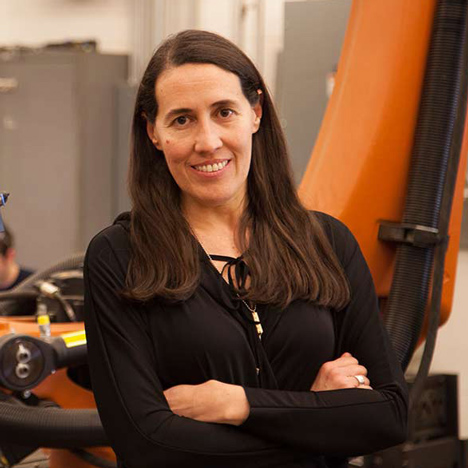
Movie Review: Hidden Figures
April 22, 2017Architects in Schools
April 22, 2017Monica Ponce de Leon Lecture
The Art Institute of Chicago, with co-sponsorship by Chicago Women in Architecture, recently hosted Monica Ponce de Leon for a lecture to discuss her work and her approach toward architecture, particularly with respect to digital fabrication. Ponce de Leon took us through a sample of her body of work with particular focus on materiality and experimentation. This is an ongoing theme in her work that extends across the built spectrum from art installation to sculpture to building and back again. What particularly captured my imagination was the idea of digital fabrication as a natural evolution and extension of hand craft, and the notion that architectural design can be an act of discovery through the exploration of materials.
One example of this exploration was a set of drawers, part of a larger interior design project for the GSD’s faculty and administrative offices. Ponce de Leon described the design process as an exploration of the function of drawers, and a new alternative to the status quo that digital fabrication permitted. Typically a dresser or file cabinet of drawers is set into a framework to contain the drawers themselves and the hardware that allows them to operate. The pieces are modular and easy to replicate. Ponce de Leon decided to examine and isolate the function of a file cabinet – the stack of movable drawers with pulls – from the framework that contains this function, and experiment with plywood as a material to generate this function as a cohesive unit apart from the containing framework. The result is a rippling face of drawers with integrated pulls that are formed from this rippling materiality, with the layers of plywood that were carved with a CNC router clearly describing the material and construction of this furniture piece. The fabrication of such a piece by hand would have been inordinately labor-intensive; with digital fabrication this ripple effect can be unique across many pieces without any additional fabrication labor. The design is only limited by the creativity of the designer and the functional properties of the material.
This experimentation process also generates “lessons learned” while working with materials and means of construction. Ponce de Leon showed an example of a scaffold installation at the University of Michigan that was digitally fabricated and used a designed joint throughout the scaffold to connect long struts together for a seamless 4-story tall slatted wall. However, the joint had to be oriented in a specific direction to function, and her team discovered an error in the design that required laborious hand-sawing at this joint and created a seam in the assembly. The lesson learned in this experiment was the need for a reversible joint, to help reduce human error in the design and assembly. This project again drove home the notion that technology and digital fabrication is indeed the natural extension of hand craft and hand technique. And the lesson learned in this experiment helped to inform the design of future projects.
One of the built projects with great visual impact is the Fleet Library installation at RISD. This work took the shape of two pavilions within an historical bank building, allowing the original building to remain in its original state. In fact, the pavilions can be completely removed from the building in which they are contained without harm to either work. In the RISD library, the theme of range over average directed the design. In looking at ergonomics and what an architect might find in Graphic Standards for a typical average to accommodate users, Ponce de Leon’s team instead approached the design to address the range of users. Ponce de Leon described this as “fabricated coincidences” – a user taking ownership of a particular carrel or desk because it fit just right. Digital fabrication permitted the creation of many varied iterations of modules. And modular assembly meant that constructing these pavilions was fast and streamlined. Instead of construction drawings in traditional architecture, the pavilions were built using assembly instructions like for flat-pack furniture. Digital fabrication also permitted the introduction of lettering and characters into the design, incorporating historical names significant to the library and RISD alongside the staff, students, designers, and even Ponce de Leon’s dog into the pavilion’s signage, creating a history of the project available to all who cared to look.
Perhaps the most transformative work was the renovation the Conrad Hotel atrium in New York. This project labored under a number of constraints that demanded an alternative approach to develop what had been a typical 15-story hotel atrium built in the 1980s. The site had a public right of way through the hotel lobby that was to remain and needed to be held above flood levels per city requirements. Previously this raised level had been virtually cut off from the street level, with little indication or invitation to pedestrians to enter and pass through. The atrium also contained a monumental Sol LeWitt painting that seemed strangely isolated from the atrium and overwhelmed the space. Ponce de Leon’s team transformed the whole right-of-way atrium space with a deliberate entry sequence from the street up to the hotel lobby level and sculpted an indoor public space with monumental steps and fluid light fixtures that draw the eye and the passerby up into a lobby-plaza. The looping light fixtures, reminiscent of the language of the Sol LeWitt painting, are hung from a series of cables from the 15-story high ceiling, creating a series of veils through which guests and pedestrians reframe their view of the painting and the atrium as they pass by on the balconies above the lobby space or through the plaza. The balconies themselves were also redesigned to better capture and contain the sound within the atrium and improve the views up and down within the space.
Too often it seems that the world of practice and the world of academia in architecture remain divorced from one another, and each fails to inform the other. Ponce de Leon has demonstrated that the success of her pedagogy has been the direct result of material investigation and experimentation. Further, this experimentation and diversity of disciplines has directly informed her practice and allowed for new means of construction and assembly in a wide range of programs and materials. One hopes this experimentation and discovery of technique and craft continues to develop and inform design across academia and practice.



